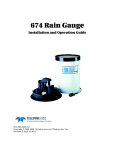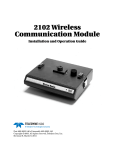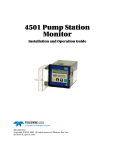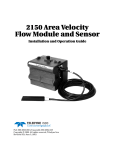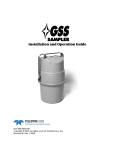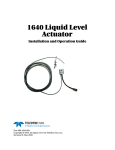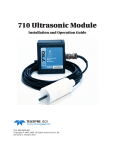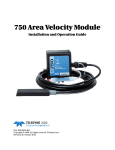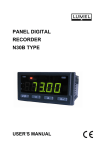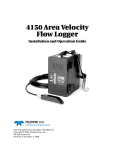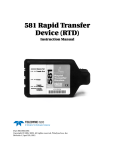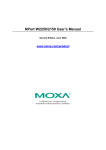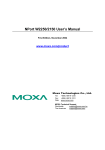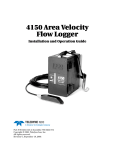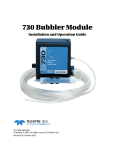Download 2108 Analog Output Module User Manual
Transcript
2108 Analog Output Module Installation and Operation Guide Part #69-2003-239 Copyright © 2002. All rights reserved, Teledyne Isco, Inc. Revision D, April 7, 2011 Foreword This instruction manual is designed to help you gain a thorough understanding of the operation of the equipment. Teledyne Isco recommends that you read this manual completely before placing the equipment in service. Although Teledyne Isco designs reliability into all equipment, there is always the possibility of a malfunction. This manual may help in diagnosing and repairing the malfunction. If the problem persists, call or e-mail the Teledyne Isco Technical Service Department for assistance. Simple difficulties can often be diagnosed over the phone. If it is necessary to return the equipment to the factory for service, please follow the shipping instructions provided by the Customer Service Department, including the use of the Return Authorization Number specified. Be sure to include a note describing the malfunction. This will aid in the prompt repair and return of the equipment. Teledyne Isco welcomes suggestions that would improve the information presented in this manual or enhance the operation of the equipment itself. Teledyne Isco is continually improving its products and reserves the right to change product specifications, replacement parts, schematics, and instructions without notice. Contact Information Customer Service Phone: (800) 228-4373 (USA, Canada, Mexico) (402) 464-0231 (Outside North America) Fax: (402) 465-3022 Email: [email protected] Technical Support Phone: Email: (800) 775-2965 (Analytical) (866) 298-6174 (Samplers and Flow Meters) [email protected] Return equipment to: 4700 Superior Street, Lincoln, NE 68504-1398 Other Correspondence Mail to: P.O. Box 82531, Lincoln, NE 68501-2531 Email: [email protected] Web site: www.isco.com Revised March 17, 2009 2108 Analog Output Module Safety 2108 Analog Output Module Safety General Warnings Before installing, operating, or maintaining this equipment, it is imperative that all hazards and preventive measures are fully understood. While specific hazards may vary according to location and application, take heed in the following general warnings. This product is often installed in confined spaces. Some examples of confined spaces are manholes, pipelines, digesters, and storage tanks. These spaces may become hazardous environments that can prove fatal for those unprepared. These spaces are governed governed by OSHA 1910.146 and require a permit before entering. Hazard Severity Levels This manual applies Hazard Severity Levels to the safety alerts, These three levels are described in the sample alerts below. CAUTION Cautions identify a potential hazard, which if not avoided, may result in minor or moderate injury. This category can also warn you of unsafe practices, or conditions that may cause property damage. WARNING Warnings identify a potentially hazardous condition, which if not avoided, could result in death or serious injury. DANGER DANGER – limited to the most extreme situations to identify an imminent hazard, which if not avoided, will result in death or serious injury. iii 2108 Analog Output Module Safety Hazard Symbols The equipment and this manual use symbols used to warn of hazards. The symbols are explained below. Hazard Symbols Warnings and Cautions The exclamation point within the triangle is a warning sign alerting you of important instructions in the instrument’s technical reference manual. The lightning flash and arrowhead within the triangle is a warning sign alerting you of “dangerous voltage” inside the product. Symboles de sécurité Ce symbole signale l’existence d’instructions importantes relatives au produit dans ce manuel. Ce symbole signale la présence d’un danger d’électocution. Warnungen und Vorsichtshinweise Das Ausrufezeichen in Dreieck ist ein Warnzeichen, das Sie darauf aufmerksam macht, daß wichtige Anleitungen zu diesem Handbuch gehören. Der gepfeilte Blitz im Dreieck ist ein Warnzeichen, das Sei vor “gefährlichen Spannungen” im Inneren des Produkts warnt. Advertencias y Precauciones Esta señal le advierte sobre la importancia de las instrucciones del manual que acompañan a este producto. Esta señal alerta sobre la presencia de alto voltaje en el interior del producto. iv 2108 Analog Output Module Table of Contents Section 1 Introduction 1.1 Overview . . . . . . . . . . . . . . . . . . . . . . . . . . . . . . . . . . . . . . . . . . . . . . . . . . . . . . . . . . 1-1 1.2 Technical Specifications . . . . . . . . . . . . . . . . . . . . . . . . . . . . . . . . . . . . . . . . . . . . . . 1-3 Section 2 Installation and Operation 2.1 2.2 2.3 2.4 2.5 2.6 2.7 2.8 Unpacking Instructions . . . . . . . . . . . . . . . . . . . . . . . . . . . . . . . . . . . . . . . . . . . . . . Mounting the 2108 . . . . . . . . . . . . . . . . . . . . . . . . . . . . . . . . . . . . . . . . . . . . . . . . . . Connection to a 2100 Series Flow Module . . . . . . . . . . . . . . . . . . . . . . . . . . . . . . . . Connecting to the 2108 Terminal Strip . . . . . . . . . . . . . . . . . . . . . . . . . . . . . . . . . . 2.4.1 System Power . . . . . . . . . . . . . . . . . . . . . . . . . . . . . . . . . . . . . . . . . . . . . . . . . Connection to a 2151P Module . . . . . . . . . . . . . . . . . . . . . . . . . . . . . . . . . . . . . . . . . Connection to a Control System . . . . . . . . . . . . . . . . . . . . . . . . . . . . . . . . . . . . . . . . Configuration in Flowlink. . . . . . . . . . . . . . . . . . . . . . . . . . . . . . . . . . . . . . . . . . . . . 2.7.1 Manual Control of Output Percentage . . . . . . . . . . . . . . . . . . . . . . . . . . . . . Cleaning. . . . . . . . . . . . . . . . . . . . . . . . . . . . . . . . . . . . . . . . . . . . . . . . . . . . . . . . . . . 2-1 2-1 2-2 2-2 2-2 2-7 2-7 2-7 2-9 2-9 Section 3 Modbus Protocol 3.1 Introduction . . . . . . . . . . . . . . . . . . . . . . . . . . . . . . . . . . . . . . . . . . . . . . . . . . . . . . . . 3.2 Operation . . . . . . . . . . . . . . . . . . . . . . . . . . . . . . . . . . . . . . . . . . . . . . . . . . . . . . . . . . 3.2.1 Establishing Communication . . . . . . . . . . . . . . . . . . . . . . . . . . . . . . . . . . . . 3.2.2 Module Addressing . . . . . . . . . . . . . . . . . . . . . . . . . . . . . . . . . . . . . . . . . . . . 3.3 Configurations . . . . . . . . . . . . . . . . . . . . . . . . . . . . . . . . . . . . . . . . . . . . . . . . . . . . . . 3.4 Glossary of Terms . . . . . . . . . . . . . . . . . . . . . . . . . . . . . . . . . . . . . . . . . . . . . . . . . . . 3.5 Common Acronyms . . . . . . . . . . . . . . . . . . . . . . . . . . . . . . . . . . . . . . . . . . . . . . . . . . 3.6 Register Specifications . . . . . . . . . . . . . . . . . . . . . . . . . . . . . . . . . . . . . . . . . . . . . . . 3-1 3-1 3-2 3-2 3-3 3-4 3-5 3-6 Appendix A Replacement Parts A.1 Replacement Parts . . . . . . . . . . . . . . . . . . . . . . . . . . . . . . . . . . . . . . . . . . . . . . . . . . A-1 List of Figures 1-1 1-2 1-3 2-1 2-2 2-3 2-4 2-5 2-6 2-7 2-8 2-9 2108 Analog Output Module - Front View . . . . . . . . . . . . . . . . . . . . . . . . . . . . . . . 2108 Analog Output Module - Back View . . . . . . . . . . . . . . . . . . . . . . . . . . . . . . . . 2108 Communication Connector Pins . . . . . . . . . . . . . . . . . . . . . . . . . . . . . . . . . . . Back View of 2108 Module . . . . . . . . . . . . . . . . . . . . . . . . . . . . . . . . . . . . . . . . . . . . 2100 Series Connect Cable . . . . . . . . . . . . . . . . . . . . . . . . . . . . . . . . . . . . . . . . . . . Identifying the 2150 voltage specification . . . . . . . . . . . . . . . . . . . . . . . . . . . . . . . Identifying the voltage specification on the DB9 cable . . . . . . . . . . . . . . . . . . . . . Terminal strip on the front of the 2108 . . . . . . . . . . . . . . . . . . . . . . . . . . . . . . . . . . Terminal connections if flow module is powered separately . . . . . . . . . . . . . . . . . Terminal Connections if Flow Module and 2108 Share Same Power Source . . . . Network connector on the front of the 2108 . . . . . . . . . . . . . . . . . . . . . . . . . . . . . . Channel 1 setup screen in flowlink . . . . . . . . . . . . . . . . . . . . . . . . . . . . . . . . . . . . . 1-1 1-2 1-4 2-1 2-2 2-3 2-4 2-4 2-5 2-6 2-7 2-8 v 2108 Analog Output Module Table of Contents 2-10 Output Channel Manual Control Screen . . . . . . . . . . . . . . . . . . . . . . . . . . . . . . . 2-9 3-1 Configuration Example (Direct Connection Shown) . . . . . . . . . . . . . . . . . . . . . . . 3-3 List of Tables 1-1 1-2 2-1 3-1 3-2 3-3 vi 2108 Analog Output Module Specifications . . . . . . . . . . . . . . . . . . . . . . . . . . . . . . 2108 Communication Connector Pins . . . . . . . . . . . . . . . . . . . . . . . . . . . . . . . . . . Voltage Specifications for 2100 System Components . . . . . . . . . . . . . . . . . . . . . . . Modbus ASCII Address 1 Register Definitions . . . . . . . . . . . . . . . . . . . . . . . . . . . . Modbus ASCII Address 2+(N-1) Register Definitions . . . . . . . . . . . . . . . . . . . . . . 2100 Measurement Parameters by Model Number* . . . . . . . . . . . . . . . . . . . . . . . 1-3 1-4 2-3 3-6 3-7 3-9 2108 Analog Output Module Section 1 Introduction 1.1 Overview The 2108 Analog Output Module converts digital data from an Isco 2150, 2110, 2151, or 2151P Flow System module to analog output. The data can then be read by a SCADA (Supervisory Control and Data Acquisition), DCS (distributed control system) or other control system instrument. The 2108 is designed to output three 2100 series measurement parameters, typically flow, level, and velocity data. The 2108 is an ABS, NEMA 1 box (see Figure 1-1) with a DIN rail mount on the back (Figure 1-2). This allows for easy installation in an equipment box/panel or a control room. A six-pin network connector on the front of the unit is used to configure the module using Isco’s Flowlink software, and can also be used to retrieve data using a Flowlink or Isco’s Field Wizard. Figure 1-1 2108 Analog Output Module - Front View The terminal strip on the front of the 2108 provides connections to a customer supplied external power supply, network connections for transmission of digital data from a 2150, 2151, or 2151P module, and three analog channel pairs which can be connected to a SCADA system or other secondary instrument. The front of the unit also contains an LED, which identifies the module when connected to Flowlink or a Field Wizard. It also indicates network activity. 1-1 2108 Analog Output Module Section 1 Introduction Figure 1-2 2108 Analog Output Module - Back View There are three connection cables that are used with the 2108. A power/communication cable (P/N 60-2004-219) attaches to the 2100 series module and to the network terminal strip on the 2108. The connector on the front of the 2108 is used to connect to a laptop computer (using RS-232 communication cable P/N 60-2004-046) or a Field Wizard (using communication cable P/N 60-2004-056). Connections are described in Section 2, which provides more detailed installation and operation instructions. 1-2 2108 Analog Output Module Section 1 Introduction 1.2 Technical Specifications This section lists the technical specifications for the 2108. Table 1-1 2108 Analog Output Module Specifications Dimensions Depth = 2.165 inches (55 mm) Width = 6.732 inches (171 mm) Height = 4.764 inches (121 mm) Weight 1.3 pounds (0.6 kg) Material ABS Enclosure NEMA 1, IP20 Power Requirements Supply DC Voltage Range nominal operating voltage: 12 volts maximum absolute voltage: 26 volts minimum operating voltage: 6.6 volts Note Earlier versions of the 2150, as well as some other system components including cables, have lower voltage limits and cannot be connected in systems powered by more than 16.6 VDC. Refer to Section 2.4.1 for complete information. Supply DC Ampere Range typical operating current: 300 mA @ 12 volts maximum standby current: 280 mA @ 12 volts maximum operating current: 580 mA @ 7.0 volts Analog Output Channels Number of channels 3 Output Range 4-20 mA outputs Maximum Load 600Ω Isolation: Output galvanically isolated from DC power, from the network and from other outputs Accuracy: Integral Nonlinearity: ±0.012% max Offset (0 mA or 4 mA) (Ta = 25°C): ±0.05%max Offset Drift: 50 ppm/°C max Total Output Error (20 mA or 24 mA)(Ta = 25°C): ±0.15% max Total Output Error Drift: 50 ppm/°C max PSRR: 10 µA/V max Resolution: 16 bits, 244 nA, 0.0015% of 16 mA span Operating Temperature -22°F to 140°F (-30°C to 60°C) Storage Temperature -40°F to 140°F (-40°C to 60°C) PC Data Link RS232 interface, capable of 38.4 Kbits per second Data Storage File system memory capacity of 512 Kbytes of data Setup and Data Retrieval PC compatible computer with Isco Flowlink for Windows software (version 4.15 or above) 1-3 2108 Analog Output Module Section 1 Introduction Table 1-2 2108 Communication Connector Pins G F A E B D C Pin Name Description A LONA Neuron differential transceiver Data A B LONB Neuron differential transceiver Data B C VIN+ Positive power supply voltage input/output D VIN– Negative power supply voltage input/output E XMTDN PC data transmit logic level output F RCVDN PC data receiver logic level input G Key Aligns connector pins Figure 1-3 2108 Communication Connector Pins 1-4 2108 Analog Output Module Section 2 Installation and Operation 2.1 Unpacking Instructions When the system arrives, inspect the outside packing for any damage. Then carefully inspect the contents for damage. If there is damage, contact the delivery company and Teledyne Isco (or its authorized representative) immediately. Teledyne Isco, Inc. Customer Service Dept. P.O. Box 82531 Lincoln, NE 68501 USA Phone: (800) 228-4373 Outside USA & Canada call: (402) 464-0231 FAX: (402) 465-3022 E-mail: [email protected] Web site: www.isco.com WARNING If there is any evidence that any items may have been damaged in shipping, do not attempt to install the unit. Please contact Teledyne Isco (or its agent) for advice. When you unpack the system, check the items against the packing list. If any parts are missing, contact the delivery company and Teledyne Isco’s Customer Service Department. When you report missing part(s), please indicate them by part number. It is recommended that you retain the shipping carton as it can be used to ship the unit in the event you need to transport it. 2.2 Mounting the 2108 The 2108 is a DIN rail mounted unit. It comes with a 7 inch (17.8 cm) piece of DIN rail (Figure 2-1) which can be used for mounting. DIN Rail DIN Rail Release Figure 2-1 Back View of 2108 Module 2-1 2108 Analog Output Module Section 2 Installation and Operation The 2108 is released from, or attached to, a DIN rail by using the rail release lever (Figure 2-1). Insert an object such as the end of a flat bladed screwdriver into the hole in the rail release and pull down to move the lever. 2.3 Connection to a 2100 Series Flow Module The 2108 is connected to a flow module (2150 area velocity or 2110 ultrasonic) with a 50 foot (15.2 m) connect cable (P/N 60-2004-219), shown in Figure 2-2. One end of the cable has six wires, which are attached to the terminal strip on the front of the 2108. The other end of the cable is attached to the connector on the underside of the flow module or 2191 battery module, whichever is applicable. Figure 2-2 2100 Series Connect Cable 2.4 Connecting to the 2108 Terminal Strip To make the connections: The terminal strip is located on the front of the 2108 (Figure 2-5). There are twelve terminals, two of which are blank (marked “X”). Terminals 1 and 2 are for power; 4 and 5 are for network connections; 7-12 are for connecting up to three analog outputs to a control system. The terminal’s screw clamp connections accept wire sizes ranging from 12 to 24 AWG. 1. Remove the terminal strip by pulling it straight out. 2. Tighten or loosen connections by turning the screw clamps with a small flathead screwdriver. 3. Once the connections are made, push the terminal strip back onto the 2108. 2.4.1 System Power 2-2 2150 modules currently sold can be powered by 7 to 26 volts. Earlier units, as well as some other 2100 system components, are limited to a maximum of 16.6 volts (12 volts typical). The voltage specification is printed on the serial tag located on the back of the module (refer to Figure 2-3). 2108 Analog Output Module Section 2 Installation and Operation Table 2-1 lists the maximum voltages for all Isco 2100 instrumentation. Regardless of the capabilities of other components, never attempt to connect a module or cable to a system using a power source that exceeds its stated operating range. Table 2-1 Voltage Specifications for 2100 System Components Module or Cable 2150 Earlier Voltage Range Current Voltage Range 7-16.6 VDC 7-26 VDC Date of Change March 2005 2110 2101 7-16.6 VDC 2103 N/A 2102 10.2-16.6 VDC 2108 7-26 VDC 2105 RS-232 DB9 Cable (part #60-2004-046) 7-16.6 VDC 7-26 VDC January 2009 RS-232 USB Cable (part #60-2004-507) 2100 Series Connect Cable, Unterminated for 2108 module or QD box 7-26 VDC N/A (part #60-2004-219) Sampler Interface Cable (part #60-2004-260) 12VDC N/A (Cable is powered from sampler.) Figure 2-3 Identifying the 2150 voltage specification The module crown connector on the earlier RS-232 DB9 digital communication cable (part #60-2004-046) is unmarked. The connector on the 26-volt cable has a serial tag specifying the higher voltage (refer to Figure 2-4). 2-3 2108 Analog Output Module Section 2 Installation and Operation Lower Voltage DB9 Cable Higher Voltage DB9 Cable Figure 2-4 Identifying the voltage specification on the DB9 cable WARNING Injury and/or equipment damage can result from connecting modules or cables to a power source exceeding the specified operating voltage range. Check labeling on all modules and cables for voltage ranges. Note All connected system components should share a common supply ground. Terminal Strip Slot on 2108 Terminal Strip Removed Terminal Strip Installed in 2108 Figure 2-5 Terminal strip on the front of the 2108 2-4 2108 Analog Output Module Section 2 Installation and Operation Connection to the terminal strip on the 2108 will vary, depending on how you are powering the flow module. If the flow module is powered separately from the 2108: 1. Connect the white-with-green-line (white/green) wire to Network A (terminal 4). 2. Connect the green-with-white-line (green/white) wire to Network B (terminal 5). 3. Insulate the remaining four wires separately from each other; they will not be connected to the terminal strip. 4. You will need to supply power to the 2108 in your equipment cabinet. Connect the DC supply voltage to terminals 1 and 2. 5. Your connections should look like those in Figure 2-6. X X Power Supply Wires Green/White Wire White/Green Wire Orange Wires Blue Wires Isco Connect Cable P/N 60-2004-219 Figure 2-6 Terminal connections if flow module is powered separately WARNING Injury and/or equipment damage can result from connecting modules or cables to a power source exceeding the specified operating voltage range. Check labeling on all modules and cables for voltage ranges. Note All connected system components should share a common supply ground. 2-5 2108 Analog Output Module Section 2 Installation and Operation If the flow module and 2108 share the same power source: 1. Connect the white/green wire to Network A (terminal 4). 2. Connect the green/white wire to Network B (terminal 5). 3. Connect the white/blue wire to terminal 1. 4. Connect the blue/white wire to terminal 2. 5. Insulate the two orange wires separate from each other; they will not be connected to the terminal strip. 6. You will need to have a power source in your equipment cabinet that supplies power to the 2108 and flow module. Connect the DC supply voltage to terminals 1 and 2 (the blue wires from the connection cable will also be connected to these terminals, as described in steps 3 and 4 above). 7. Your connections should look like those in Figure 2-5. X X Green/White Wire Power Supply Wires Blue/ White Wire White/Green Wire White/Blue Wire Orange Wires Isco Connect Cable P/N 60-2004-219 Figure 2-7 Terminal Connections if Flow Module and 2108 Share Same Power Source WARNING Injury and/or equipment damage can result from connecting modules or cables to a power source exceeding the specified operating voltage range. Check labeling on all modules and cables for voltage ranges. Note All connected system components should share a common supply ground. 2-6 2108 Analog Output Module Section 2 Installation and Operation 2.5 Connection to a 2151P Module The 2108 can be used with Isco’s intrinsically safe 2151P area velocity flow system. Details concerning installation of the 2151P can be found in that module’s user manual. 2.6 Connection to a Control System The terminal strip on the 2108 has three analog galvanically isolated output channel pairs that allow for connection to your SCADA, DCS, or other control system. Each output has a 4-20 mA range by default. If a 0-20 mA range is desired, contact Teledyne Isco to have your 2108 unit configured at the factory. The load capacity for each output is 600 ohms. Connect the wires from your control system to terminals 7 through 12 on the terminal strip, as appropriate. 2.7 Configuration in Flowlink Each analog output needs to be configured with Isco’s Flowlink for Windows software. The 2108 can be connected to a laptop computer or Isco Field Wizard by using the six-pin network connector on the front of the 2108 (refer to Figure 2-8). For connection to a laptop computer, use Isco’s RS-232 communication cable P/N 60-2004-046. For connection to a Field Wizard, use communication cable (P/N 60-2004-056). Figure 2-8 Network connector on the front of the 2108 Note The 2108 requires Flowlink 4.15 or later. Earlier versions do not support 2108 modules. Flowlink Help Detailed Flowlink instructions are beyond the scope of this manual. Flowlink’s operating instructions are available in a Windows Help format. You can access the help topics for an active window by clicking on its Help button or by pressing F1 on your computer’s keyboard. You can also access Help topics from a Contents and Index window (HELP>CONTENTS AND INDEX from the Flowlink menu). To configure the analog outputs in Flowlink, follow the instructions below: 2-7 2108 Analog Output Module Section 2 Installation and Operation 1. Make the necessary connections for Flowlink to communicate with the site. Then, using Flowlink, connect to the site. 2. From the Measurements tab, select Channel 1. The screen shown in Figure 2-9 will be displayed. Figure 2-9 Channel 1 setup screen in flowlink 3. From the Channel 1 Setup screen, click the down arrow by Measurement Input. 4. Select the input you want to measure (such as level) and click the Apply F9 button on the bottom of the screen. 5. After you have specified your measurement input, enter the settings for the Output Channel Name, Minimum Range, Maximum Range, and Update Interval. 6. Repeat steps 2 through 5 for Channels 2 and 3 if needed. If desired, you can store data for your channels, to be retrieved later as data sets that can be used in graphs and tables. When you are setting up a channel, click on the Set Up Data Storage button to display the Data Storage Setup screen. Complete the information requested and click on OK. 2-8 2108 Analog Output Module Section 2 Installation and Operation 2.7.1 Manual Control of Output Percentage If you need to temporarily override the output for a channel (to calibrate equipment, for example), go to the appropriate Channel Setup screen and click the Manual Control button. You will see the following dialog box: Figure 2-10 Output Channel Manual Control Screen Set the output channel percentage by selecting the desired percentage or by selecting Custom and entering a percentage amount. Click the Set Output Channel Percentage button. The output will change to your manual setting, but the dialog box will remain on the screen. It will remain there until you click the Cancel button. Then the output will revert to your previous settings. 2.8 Cleaning Take care when cleaning the 2108 module. Avoid getting liquids in the terminal connections or the communication connector. Do not immerse the module in any liquids. CAUTION Do not immerse the module in a bath for cleaning. The 2108 is not hermetically sealed. If internal components get wet, the module may be permanently damaged. 2-9 2108 Analog Output Module Section 2 Installation and Operation 2-10 2108 Analog Output Module Section 3 Modbus Protocol Sections 3.1 through 3.5 give an overview of the basic capabilities and operation of Modbus protocol as it applies to Isco 2100 Series flow modules. For a Glossary of Terms and Common Acronyms, see sections 3.4 and 3.5. For Modbus technical specifications, turn to section 3.6. 3.1 Introduction Modbus is a simple command/response mechanism to read from and write to specific memory locations called registers. A register is a holding place for a piece of digital information within the equipment. There are three standard protocols for Modbus: Modbus RTU, Modbus TCP/IP, and Modbus ASCII. The Isco 2100 Series devices use Modbus ASCII protocol, the method discussed in this manual. Modbus ASCII has more flexible communication timing requirements. Modbus communication for the Isco 2100 Series provides a standard protocol that can be used to retrieve real-time data from a single module or stack of modules at a site, or multiple sites, over a wide area. The data can be sent to a central computer for display, data collection, or process control. Modbus implementation is independent of Flowlink and cannot alter the Flowlink-programmed configuration of the module. Modbus cannot be used to retrieve historical data from a module’s memory. Due to the wide variety of configurations that can be made with Modbus, it is impossible to cover every usable application. This section will discuss the overall capabilities and operation of Modbus. 3.2 Operation There are many standard, third party Modbus drivers and OPC servers that may be used to link a remote Modbus device, such as a 2100 Series module, to SCADA or process control software, such as Wonderware™ or Intellution™. The OPC server communicates with the remote instrumentation and accesses registers. The definition of what information is contained and where (the register number, or address) is decided by the manufacturer (Teledyne Isco). In a 2100 module, the registers hold, but are not limited to, the current real-time value of the meter’s level, velocity, flow, input voltage, temperature, and total flow readings, stored in specified register locations. A list of the 2100 register addresses, and what parameters are held where, is available in section 3.6. 3-1 2108 Analog Output Module Section 3 Modbus Protocol By accessing these registers you can obtain the current value of whatever parameter you desire. The reading(s) can then be displayed or stored wherever you designate as a destination; for example, a process control computer. Note Level, flow, velocity, and temperature data is stored in metric units only. Not all registers are limited to read-only data storage. You can also use some registers for control purposes. For example, by writing a “1” value to register 24 (“Identify Module” register), you will tell a 2100 module to light the LED on the front of the module. 3.2.1 Establishing Communication There are several different communications protocols supported in the 2100 series that require auto-baud rate detection. Because of this, each time a modbus connection is made, the module uses a polling mechanism to repeatedly send a command until a response is received. It may take up to 20 command retries before the module has identified the baud rate and a response is received. 3.2.2 Module Addressing When connecting to a site via a Modbus OPC server, you use a dedicated line of communication to that module or stack from the OPC server, which can be a dedicated communications cable (direct connection) or a dedicated phone number (modem). When you are using a direct connection, you are dedicating a specified COM port on the computer, and that COM port determines the site to which you are connecting. When you are using a modem, the dedicated line is defined by the site's phone number. If you connect more than one 2100 Series module at a site, the Modbus OPC server, while using the shared communication line for all of the modules within the network, must have some way to differentiate between the modules. When sending a command to a specific module, the command has an address field. This allows the server software to talk to, as well as control, the specified module, while ignoring other modules in the same stack or site. Each module capable of Modbus Protocol communication will automatically create its own specific ASCII address within the site, using: • The model numbers of the modules • The user-defined module names 3-2 2108 Analog Output Module Section 3 Modbus Protocol 3.3 Configurations A variety of configurations can be made with Modbus, either through direct connection or through a modem. In the example shown in Figure 3-1, you are direct-connecting a server PC to two individual 2150s through Modbus, using the COM ports on the OPC Server, which are directly connected to the remote 2150s. Connection to the module is made through the RS-232 communication port on the top of the module. Note For low power operation, we recommend connecting the module(s) to the computer using the straight-through cable (Isco part number 60-5314-529), which consumes less power, instead of our standard interrogation cable. In Figure 3-1, the OPC Server PC must have two COM ports. Modbus requires one COM port each, for direct connection of each 2150. COM port 1 2150 OPC Server Process Control 2150 COM port 2 Figure 3-1 Configuration Example (Direct Connection Shown) The operation sequence for the example above can be summarized in the following steps: 2150: 1. 2150s take readings from probes. 2. 2150s store readings (level, velocity, flow rate, etc.) in their specified registers. Process Control: 3. The user requests data through Process Control. 4. Process Control asks the OPC server to gather information. 3-3 2108 Analog Output Module Section 3 Modbus Protocol 5. OPC connects to the 2150 stack through the cable (direct connection), takes register data from the specified 2150, and populates the OPC server's holding index. 6. Process Control takes data from the OPC server's holding index and gives data to the user. Note that Process Control can be either manual or automated in this example, and that the OPC server and Process Control may be located physically on the same computer. 3.4 Glossary of Terms ASCII – Short for American Standard Code for Information Interchange, ASCII is a code that represents English characters with numbers. Most computers represent text with ASCII code, making it possible for one computer or device to share data with another. 2100 modules support Modbus ASCII protocol. Dedicated Line – A telecommunications path reserved for communication between two specified points and not shared among multiple points. Modbus Protocol – Modbus Protocol is a messaging structure used to establish master-slave/client server communications between intelligent devices. Modbus is a simple command/response mechanism to read from and write to registers. OPC – OPC (OLE for Process Control) means open connectivity via open (free for use) standards. It is a series of software standards specifications that fill a need in automation (like printer drivers did for Windows), acting as a translator for data transmission and process control. The specification defines a standard set of objects, interfaces, and methods for use in process control and manufacturing automation applications to facilitate interoperability. There are hundreds of OPC Data Access servers and clients. Registers – Registers are locations in memory that have specific data stored for retrieval or are used for control functions. A register is a holding place for a piece of digital information within the equipment. The definition of what is contained and where (the registry number, or address) is decided by the manufacturer (in this case Teledyne Isco). SCADA – SCADA (Supervisory Control And Data Acquisition) is a computer system for gathering and analyzing real-time data. SCADA systems are used to monitor and control plant operation, or equipment in industries such as telecommunications, water and waste control, energy, oil and gas refining, and transportation. The SCADA system transfers the information (for example, where a leak has occurred in a pipeline), back to a central site, alerting the home station of the leak, performing necessary analysis and control (such as determining if the leak is critical), and displaying the information in a logical and organized manner. 3-4 2108 Analog Output Module Section 3 Modbus Protocol SCADA systems can be relatively simple, such as one that monitors the environmental conditions of a small office building, or very complex, such as a system that monitors all the activity in a nuclear power plant or a municipal water system. 3.5 Common Acronyms ASCII – American Standard Code for Information Interchange DCS – Distributed Control Systems MTU – Master Terminal Unit OPC – Object Linking and Embedding (OLE) for Process Control PLC – Programmable Logic Controller RTU – Remote Terminal Unit SCADA – Supervisory Control And Data Acquisition TCP/IP – Transmission Control Protocol/Internet Protocol 3-5 2108 Analog Output Module Section 3 Modbus Protocol 3.6 Register Specifications All numbers in the Modbus registers are stored most significant byte first. If the polling device has a byte ordering of least significant byte first (an Intel-based PC, for example), the bytes will need to be reversed after they are received. The Modbus ASCII address is used to index the data by modules. Modbus ASCII address 1 contains information related to the site. The first register contains a 16-bit integer count of the number of modules that have data to report. The maximum number of modules that can be supported is 4. Modbus ASCII addresses 2 through the number of modules plus 1 contain data from the individual modules. The Modbus ASCII addresses will be sorted by the model number, and then by module name, which is entered by the user through Flowlink. This allows the user to control the ordering of the addresses and easily predict what data will be in specific registers. Every measured parameter has a corresponding status and measurement time that are updated with each measurement. The maximum number of supported measurements from all modules in the system is 28. The Modbus registers are assigned within 30 seconds after the 2100 module is powered up. To conserve power for the users who do not use Modbus communications, no Modbus registers will be updated with sensor readings until a Modbus master communicates with the 2100 module. The register definitions for the Site Information device (Modbus ASCII address 1) are in Table 3-1 below: Table 3-1 Modbus ASCII Address 1 Register Definitions Register Number(s) 3-6 Name Data type Units Read/Write 1 Number of modules (N) (1-4) 16 bit integer None Read 2-20 Site name 38-byte string None Read 2108 Analog Output Module Section 3 Modbus Protocol The register definitions for the individual modules (Modbus ASCII addresses 2+(N-1)) are in Table 3-1 below: Table 3-2 Modbus ASCII Address 2+(N-1) Register Definitions Register Number(s) Name Data Type Units Read/Write 1-4 Model number 8-byte string None Read 5-23 Module name 38-byte string None Read 241 Identify module 16 bit integer None Read/Write 2 Take reading flag 16 bit integer None Read/Write 3 26 Update interval 16 bit integer Seconds Read/Write 274 Active flag 1 16 bit field None Read 28 Active flag 2 16 bit field None Read 29 Active flag 3 16 bit field None Read 30 Active flag 4 16 bit field None Read 40,41 Level 4-byte float Meters Read 42 Level status code5 16-bit integer Read 43-52 Level time record Time6 Read 55,56 Velocity 4-byte float 57 Velocity status code 16-bit integer Read 58-63 Velocity time record Time Read 70,71 Flow 4-byte float 72 Flow status code 16-bit integer Read 73-78 Flow time record Time Read 85,86 Flow 1 4-byte float 87 Flow 1 status code 16-bit integer Read 88-93 Flow 1 time record Time Read 100,101 Volume 4-byte float 102 Volume status code 16-bit integer Read 103-108 Volume time record Time Read 115,116 Volume 1 4-byte float 25 Meters/second Cubic Meters/sec Cubic Meters/sec Cubic Meters Cubic Meters Read Read Read Read Read 3-7 2108 Analog Output Module Section 3 Modbus Protocol Table 3-2 Modbus ASCII Address 2+(N-1) Register Definitions (Continued) Register Number(s) Name Data Type Units Read/Write (1) A write to the Identify module register will cause the module to perform the identify operation which may be a steady LED for a few seconds or a beep in the Field Wizard. (2) Setting the Take Reading flag to 1 will cause the module to update the registers with current data readings. It will be set to zero when the readings have all been updated. This may be used to initiate readings and poll for when they are ready to be read. It may take up to 50 seconds to update all the readings, depending upon the flow conditions. Setting the Take Reading flag to 2 causes an automatic, 15 second update of readings when a Modbus master is polling the 2100. (3) The Update Interval specifies an interval in seconds that the registers are automatically updated. It defaults to zero, which indicates that no automatic updating will occur. (4) The Active Flag (1-4) bit fields specify what fields/registers are active in the list. This provides support for a maximum of 64 fields. For example, if bit 0 of register 27 is set, the Level (registers 40,41) is active. If bit 1 of register 27 is set, then the Velocity (registers 55,56) is active. If bit 0 of register 28 is set, the Analog channel 7 (registers 265,266) is active. (5)A non-zero status code indicates a measurement problem. (6) Time is represented in a series of registers: Order is from lowest address to highest - Seconds (0-59), Minutes (0-59), Hours (0-23), Days (1-31), Month (1-12) and Year (1977-2099). 3-8 117 Volume 1 status code 16-bit integer Read 118-123 Volume 1 time record Time Read 130,131 Voltage 4-byte float 132 Voltage status code 16-bit integer Read 133-138 Voltage time record Time Read 145,146 Temperature 4-byte float 147 Temperature status code 16-bit integer Read 148-153 Temperature time record Time Read 160,161 Internal Temp 4-byte float 162 Internal Temp status code 16-bit integer Read 163-168 Internal Temp time record Time Read 175,176 Analog channel 1 4-byte float 177 Analog channel 1 status code 16-bit integer Read 178-183 Analog channel 1 time record Time Read 190,191 Analog channel 2 4-byte float 192 Analog channel 2 status code 16-bit integer Read 193-198 Analog channel 2 time Record Time Read 205,206 Analog channel 3 4-byte float 207 Analog channel 3 status code 16-bit integer Read 208-213 Analog channel 3 time record Time Read 220,221 Analog channel 4 4-byte float 222 Analog channel 4 status code 16-bit integer Read 223-228 Analog channel 4 time record Time Read 235,236 Analog channel 5 4-byte float 237 Analog channel 5 status code 16-bit integer Volts Degrees Celsius Degrees Celsius 0-100 percent 0-100 percent 0-100 percent 0-100 percent 0-100 percent Read Read Read Read Read Read Read Read Read 2108 Analog Output Module Section 3 Modbus Protocol Table 3-2 Modbus ASCII Address 2+(N-1) Register Definitions (Continued) Register Number(s) Name Data Type Units Read/Write 238-243 Analog channel 5 time record Time 250,251 Analog channel 6 4-byte float 252 Analog channel 6 status code 16-bit integer Read 253-258 Analog channel 6 time record Time Read 265,266 Analog channel 7 4-byte float 267 Analog channel 7 status code 16-bit integer Read 268-273 Analog channel 7 time record Time Read 280,281 Analog channel 8 4-byte float 282 Analog channel 8 status code 16-bit integer Read 283-288 Analog channel 8 time record Time Read Read 0-100 percent 0-100 percent 0-100 percent Read Read Read Table 3-3 2100 Measurement Parameters by Model Number* 2103, 2103c/g, 2105, 2105c/g 2108 Voltage 2110 2150, 2151, 2151P Analog channel 1 Level Level Analog channel 2 Flow Velocity Analog channel 3 Volume Flow Voltage Flow 1 Temperature Volume Volume 1 Voltage Temperature *Single module only; does not include any additional connected devices. Subject to change. 3-9 2108 Analog Output Module Section 3 Modbus Protocol 3-10 2108 Analog Output Module Appendix A Replacement Parts A.1 Replacement Parts Replacement parts are called out in the following page. Refer to the call-outs in the adjacent table to determine the part number for the item. Replacement parts can be purchased by contacting Teledyne Isco’s Customer Service Department. Teledyne Isco, Inc. Customer Service Department P.O. Box 82531 Lincoln, NE 68501 USA Phone: (800) 228-4373 (402) 464-0231 FAX: (402) 465-3022 E-mail: [email protected] Web site: www.isco.com A-1 2108 Analog Output Module Appendix A Replacement Parts A-2 Compliance Statements DECLARATION OF CONFORMITY Application of Council Directive: Manufacturer's Name: Manufacturer's Address: Description Electrostatic Discharge EN61000-4-3 Radiated RF Immunity EN61000-4-4 Electrical Fast Transient CISPR11/ EN 55011 RF Emissions Severity Applied C E EN61000-4-2 Performance Criteria Level 2 - 4kV contact discharge Level 3 - 8kV air discharge A A 80 MHz to 1000MHz 80% AM at 1kHz Level 1 – 10V/m A Level 1 – 1kV on I/O lines A D ec la ra ti o n Standard of C on fo r m ity Equipment Type/Environment: Trade Name/Model No: Year of Issue: Standards to which Conformity is Declared: 89/336/EEC – The EMC Directive 73/23/EEC – The Low Voltage Directive Teledyne Isco, Inc. 4700 Superior, Lincoln, Nebraska 68504 USA Mailing Address: P.O. Box 82531, Lincoln, NE 68501 Laboratory Equipment for Light Industrial/Commercial Environments 2108 Analog Output Module 2002 EN 61326-1998 EMC Requirements for Electrical Equipment for Measurement, Control, and Laboratory Use EN 61010-1 Safety Requirements for Electrical Equipment for Measurement, Control and Laboratory use. Group 1, Class A Industrial, Scientific, and Medical Equipment We, the undersigned, hereby declare that the design of the equipment specified above conforms to the above Directive(s) and Standards as of October 22, 2002. William Foster USA Representative William Foster Director of Engineering Teledyne Isco, Inc. 4700 Superior Street Lincoln, Nebraska 68504 Phone: (402) 464-0231 Fax: (402) 464-4543 60-2002-234 Rev. A Warranty Teledyne Isco One Year Limited Warranty* Factory Service for Teledyne Isco Flow Meters, Waste Water Samplers, and Syringe Pumps This warranty exclusively covers Teledyne Isco instruments, providing a one-year limited warranty covering parts and labor. Any instrument that fails during the warranty period due to faulty parts or workmanship will be repaired at the factory at no charge to the customer. Teledyne Isco’s exclusive liability is limited to repair or replacement of defective instruments. Teledyne Isco is not liable for consequential damages. Teledyne Isco will pay surface transportation charges both ways within the 48 contiguous United States if the instrument proves to be defective within 30 days of shipment. Throughout the remainder of the warranty period, the customer will pay to return the instrument to Teledyne Isco, and Teledyne isco will pay surface transportation to return the repaired instrument to the customer. Teledyne Isco will not pay air freight or customer’s packing and crating charges. This warranty does not cover loss, damage, or defects resulting from transportation between the customer’s facility and the repair facility. The warranty for any instrument is the one in effect on date of shipment. The warranty period begins on the shipping date, unless Teledyne Isco agrees in writing to a different date. Excluded from this warranty are normal wear; expendable items such as charts, ribbon, lamps, tubing, and glassware; fittings and wetted parts of valves; and damage due to corrosion, misuse, accident, or lack of proper maintenance. This warranty does not cover products not sold under the Teledyne Isco trademark or for which any other warranty is specifically stated. No item may be returned for warranty service without a return authorization number issued by Teledyne Isco. This warranty is expressly in lieu of all other warranties and obligations and Teledyne Isco specifically disclaims any warranty of merchantability or fitness for a particular purpose. The warrantor is Teledyne Isco, Inc. 4700 Superior, Lincoln, NE 68504, U.S.A. * This warranty applies to the USA and countries where Teledyne Isco Inc. does not have an authorized dealer. Customers in countries outside the USA, where Teledyne Isco has an authorized dealer, should contact their Teledyne Isco dealer for warranty service. Before returning any instrument for repair, please call, fax, or e-mail the Teledyne Isco Service Department for instructions. Many problems can often be diagnosed and corrected over the phone, or by e-mail, without returning the instrument to the factory. Instruments needing factory repair should be packed carefully, and shipped to the attention of the service department. Small, non-fragile items can be sent by insured parcel post. PLEASE BE SURE TO ENCLOSE A NOTE EXPLAINING THE PROBLEM. Shipping Address: Mailing Address: Phone: Fax: Email: Teledyne Isco, Inc. - Attention Repair Service 4700 Superior Street Lincoln, NE 68504 USA Teledyne Isco, Inc. PO Box 82531 Lincoln, NE 68501 USA Repair service: (800) 775-2965 (lab instruments) (866) 298-6174 (samplers & flow meters) Sales & General Information: (800) 228-4373 (USA & Canada) (402) 465-3001 [email protected] March 8, 2011 P/N 60-1002-040 Rev E








































